| |
Home
Famous and Fascinating Women in History
Frontiersmen and Women
The World's Greatest Composers
Famous Women Spies
Great Authors of the World
Generals and other Noteworthy People
from the Civil War
The Presidents of the United States
The First Ladies of the United States
Homes and Monuments of and to
Famous People
Historical People and Events by Month for Each Day of the Year!
Famous Figures in Black History
The Calvert Family and the Lords Baltimore
Understanding the American Revolution and its People
Everything Beatles!
Everything Maryland! |
| |
|
 
|
| |  |  |
 |  | 
Zachary Taylor: His Life and Homes
By
John T. Marck
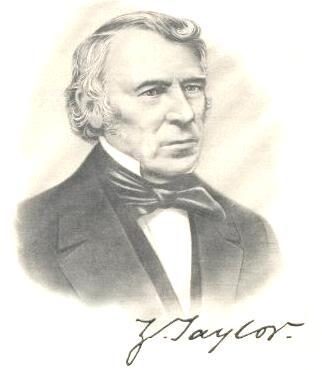
Colonel Richard and Sarah Dabney Taylor were very prominent and
wealthy landowners who lived at Hare Forest, a plantation in Orange
County, Virginia, near Culpepper. In 1784, Colonel Taylor sold
the property and set out to find a new home with his family and
slaves. On their journey, members of their party contracted measles,
so they all had to be quarantined immediately. In their hurry to
secure a place to live, they acquired temporary lodging on a
plantation called Montebello, near Barboursville, still in Orange
County, Virginia.
At Montebello, Zachary Taylor was
born on November 24, 1784, their third son. Although these original
buildings no longer exist, it is believed that Zachary was born in a
log cabin. Colonel Taylor then traveled to Kentucky with his slaves,
leaving his family and sons at Montebello, to establish a new home at
Springfield, near Louisville.
Zachary's
Boyhood Home
When Zachary was still an infant,
in late fall 1784, he moved with his family to their new home at
Springfield. Zachary's
father purchased this 400-acre farm in the Beargrass Creek region, in
Jefferson County, just east of the city limits of Louisville. The
Taylor's,
being well established and prominent in Virginia, continued to be
regarded as such in Kentucky. Within a short time, the farm had
expanded to 700 acres, and soon thereafter, Colonel Taylor owned more
than 10,000 acres in seven Kentucky counties. At Springfield, Colonel
and Mrs. Taylor would have six more children, for a total family of
nine, of which eight survived into adulthood.

Life in Springfield
It would be here that
Zachary would spend his first twenty-three years. The original house
in which he first lived was built by his father, Colonel Taylor and
his slaves, and was a log home. This house was later moved to
the back of their property for slave quarters, being replaced by the
current structure. This house is a large two and one-half story
Georgia Colonial red brick, Flemish bond house that was constructed in
a style similar to a Virginia plantation house and all the bricks used
were fired on the property. The home had two rooms on each floor and
featured walnut wood and ash flooring.
Between the years 1810 and 1820, a
second side of the house was built, that also had two rooms on each
floor and featured the same ash flooring. The only difference between
the sides was this addition had wider mantels and larger fireplaces,
and the wood was painted, rather than walnut stain as was done in the
older sections.
Military Career and Marriage
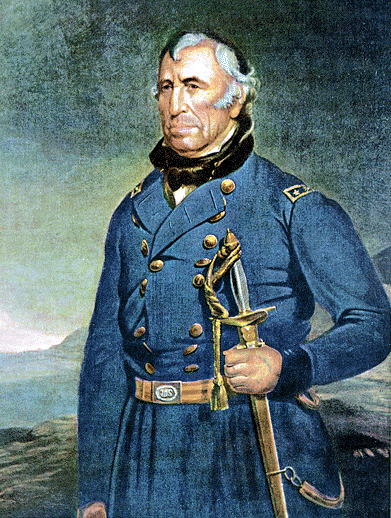
In 1808, Zachary left Springfield
to pursue his military career, receiving his first commission as an
officer, becoming commander of the garrison at Fort Pickering, which
is today the site of Memphis, Tennessee. Taylor=s
military career would span 40 years, which expanded his professional
reputation, but having to move from one frontier post to another, made
his personal life difficult.
Margaret Smith was born at St.
Leonard's in Calvert County, Maryland, the daughter of Richard and Ann
Mackall Smith. When Margaret was twenty-one, she visited her sister
Mary Chew at her plantation in Kentucky, near Louisville. It was here
that she met a young Lieutenant named Zachary Taylor, who was
stationed there in the Army. They married on June 21, 1810, and lived
on the plantation his father built on Beargrass Creek. For many years
they traveled back and forth between their home and military outposts.
Finally, they were stationed in Baton Rouge, Louisiana, and there they
settled into what would be their permanent home, on the army post, in
a house previously owned by the former commandant.

During Zachary's
military career, he won fame as an
"Indian
Fighter,"
in the present-day states of Wisconsin, Minnesota, Mississippi,
Oklahoma, Kansas, Louisiana, Arkansas, Florida and Texas. Although
known for fighting Native Americans, Taylor also fought on their
behalf against invading white settlers. It was his belief that for
settlers and Native Americans to coexist, a strong military presence
was needed to keep them apart.
In 1845, the Mexican War began,
whereby Texas was granted statehood. Mexico disputed the lands along
the border and President Polk ordered Taylor and his troops into the
contested area. This deployment began the Mexican-American War. Taylor's
military abilities were brilliant, winning two decisive battles, and
then facing overwhelming odds, defeated General Santa Anna at Buena
Vista. In the end, Taylor's
forces of 6,000 had defeated the Mexican force of 20,000. Zachary
Taylor, known as
"Old
Rough and Ready,"
was now a national hero.
Following his military victories,
many were still not sure of his political preference. Being a wealthy
slave owner, those in the South hoped he would support states'
rights and the expansion of slavery into the new areas won from
Mexico. Those in the North were comfortable in his service in
the military on the nation's
behalf, and thus hoped he was a Union man.
In truth, Zachary thought himself
to be more of an independent. He had differences with Democrats
over the concept of a strong national bank and opposed the extension
of slavery into areas where either cotton or sugar could be grown. He
also differed with the Whigs'
support of strong protective tariffs, and he passionately opposed
secession as a means of resolving problems that faced the nation.
Ultimately, he finally announced that he was a Whig. Consequently, at
their 1848 convention, the Whigs named Taylor for President, adding
Millard Fillmore to the ticket. This was done to appease those
who opposed the nomination of a slave owner, or who were doubtful of
Taylor's
total commitment to the Whig Party.

For the first time in our history,
the entire nation voted on the same day, November 7, 1848. Taylor and
Fillmore were elected, although narrowly, defeating the Democratic
nominations headed by Michigan's
Lewis Cass, and the ticket of the Free-Soil Party, led by former
President Martin Van Buren.

Taylor's
foremost agenda was the issue of slavery. The nation was
consumed over the question whether to extend slavery to the new
western territories. Taylor believed that the people in California,
and New Mexico, as well as the Mormon population around Salt Lake,
should be permitted to decide themselves, whether to allow slavery or
not. He felt that they should write their own constitutions and apply
for statehood. By doing so, the sectional debate over congressional
prohibition of slavery in any of these territories could be avoided.
Those in the South feared that the addition of two new Free states
would upset the already delicate North-South balance in the Senate.
The Southern Democrats responded by
calling for a secession convention, of which Taylor replied by saying
he would hang anyone who tried to disrupt the Union by force or by any
conspiracy action. Because of this, the atmosphere became very heated,
and Henry Clay, Daniel Webster and others began to side together
toward a compromise in the Senate. To pacify the South, they
proposed the Fugitive Slave Law that would mandate the return of
escaped slaves that were apprehended anywhere in the country. This
effort became the Compromise of 1850.
However, the compromise legislation
did not permit slavery in California, which was admitted as a free
state, as well as it allowed for the organization of Utah and New
Mexico as formal territories, rather than states, with no federal
restrictions of slavery. By doing this, the window was left open
for these territories to adopt slavery if they desired, and future
Congresses to admit them as slave states. Northerners were outraged by
that concession made for the South and it only heightened their
opposition to the further extension of slavery. It would be this issue
that was pushing the nation closer and closer to Civil War.
During this time, strong leadership
was needed, and Taylor refused to participate directly with Congress,
believing that a President should stand above party politics, which
probably damaged his cause.
On July 4, 1850, at the laying of
the cornerstone of the Washington Monument, Taylor remained in the hot
sun for many hours, and became ill from the heat. He returned to the
White House, with a fever, very fatigued. Within five days the
President was dead, dying on July 9. More than 100,000 people lined
the streets to view the funeral procession. Still, he left a country
divided, and a vice president in Millard Fillmore who supported the
Compromise of 1850.
Unfortunately, Taylor had a very
limited impact as President, and he did little to slow down or prevent
the greatest national tragedy to come, that of the Civil War.
Margaret Taylor
as First Lady
When Zachary was elected President,
and they moved into the White House, Margaret, or Peggy as she was
called, lived very privately there, acting as though it was her own
home. When visitors came to the White House, she assumed they were
only there to see the President, so she never displayed herself.
Instead, she would entertain her own friends and guests to private
dinner parties. Not being interested in the duties of an
official hostess, Peggy appointed her daughter Betty to this position,
who handled the responsibility well. Peggy had endured many hardships
throughout her life, but her final grief came from her husband's
unexpected death in 1850, after just sixteen months as President. Her
husband's death broke her spirit and her will to live. Peggy died on
August 18, 1852 at the home of her daughter Betty, in Pascagoula,
Mississippi.
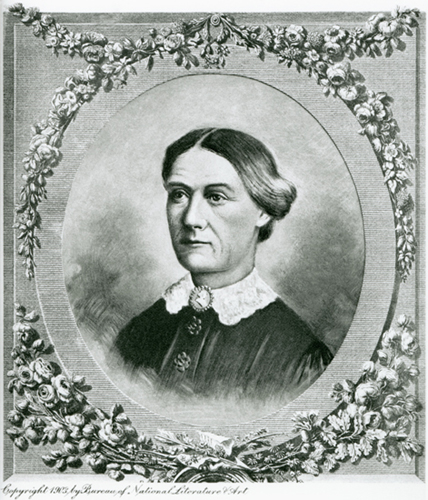
If Taylor Had Completed His
Term
There has always been much debate
over what may have occurred if Taylor had finished his term in office,
and perhaps had been elected to a second term. President Taylor had
just revamped his cabinet of the eve of his death. This brought in men
of national prominence that would have given the President one of the
strongest cabinets ever assembled in history. Had Taylor lived, there
might not have been the Compromise of 1850, or even the Civil War.
In 1850, the South was too disorganized to form a feasible secession
movement, and Taylor's
support for the direct admission to the Union of the western
territories might have changed the course of history. Being the great
military leader he was, and surprising many when he defeated Santa
Anna at Buena Vista, the debated question was if he had survived,
would he have been able to stamp out the burning issue in 1850, that
of the expansion of slavery westward. Sadly, we will never
know.
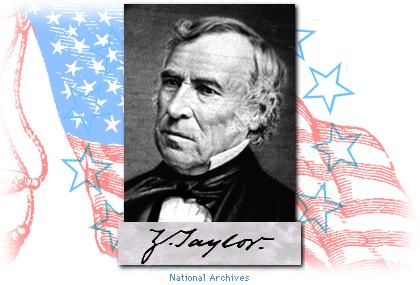
Over the years since his death,
there was speculation by historians that he may have died from arsenic
poisoning. In 1901, one such person convinced his descendants that he
might have been poisoned. Consequently, Taylor's
remains were exhumed from the cemetery in Louisville, and the Kentucky
medical examiner took samples of hair and fingernail tissue to the Oak
Ridge Laboratory for study. In the Chemical and Analytical Sciences
Division they used a neutron activation analysis to measure the amount
of arsenic in the samples. While most human bodies contain traces of
arsenic, the issue was whether the samples contained more arsenic than
was normal, after 141 years in the crypt.
Arsenic levels were calculated and
then sent back to the Kentucky medical examiner for a decision. After
review, it was determined that the arsenic levels found were several
hundred times less than they should have been had he been poisoned.
This finding acquitted several of Taylor's
contemporaries of suspicion of murder and proved finally that he was
indeed not poisoned.
President Taylor held the opportunity to possibly have the nation
avoid the Civil War. After his death, the forces of compromise
triumphed, and the war Taylor may have faced came eleven years later.
In it, his only son, Richard, served as a general in the Confederate
Army. In a broad sense, Taylor was sort of an anomaly. He owned slaves
yet supported the ban of the expansion of slavery into the western
territories. He was the victorious military winner of Mexico, who saw
no need for Manifest Destiny. He was an army general who avoided war
as an instrument, a stern military commander, but one who avoided
decisive actions as president. One thing was clear concerning him
though; he was committed to preserving the Union, even if this meant
using force against those who desired to secede.
Quick
Biographical Facts:
ZACHARY TAYLOR
12th President
Term- March 4, 1849 to July 9, 1850
Whig Party
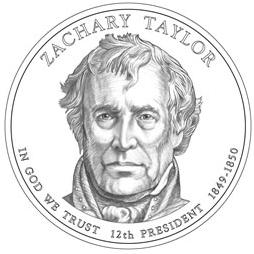
Birth: "Montebello” in Orange
County, Virginia, November 24, 1784.
Ancestry: English
Marriage: Jefferson County,
Kentucky, June 21, 1810 to Margaret Mackall Smith, who was born in
Calvert County, Maryland, September 21, 1788. Margaret died near
Pascagoula, Mississippi, August 18, 1852 and is buried in Zachary
Taylor National Cemetery, Louisville, Kentucky.
Children: Anna Mackall (1811-1875);
Sarah Knox (1814-1835); (Sarah Knox married Jefferson Davis, June 17,
1835 in Lexington, Kentucky, who became President of the Confederate
States of America, in 1861. Octavia Pannill (1816-1820); Margaret
Smith (1819-1820); Maly Elizabeth (1824-1909); Richard (1826-1879).
Home: "Springfield," Louisville,
Kentucky
Education: Limited tutorial
Religion: Episcopalian
Occupation before Presidency:
Soldier, farmer.
Military Service: Volunteer in
Kentucky Militia (1803); Major General U.S. Army (1808-1849).
Age at Inauguration: 64
Taylor Administration: Vice
President: Millard Fillmore of New York.
Inauguration: March 4, 1849, The
Capitol, Washington, D.C.
Death: Washington, D.C., July 9,
1850.
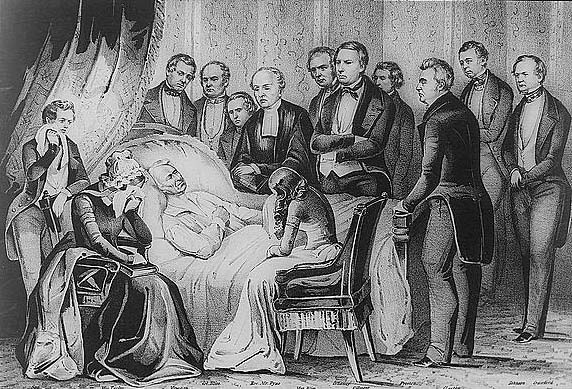
Cause of Death: After many hours in
the hot sun on July 4, he became fatigued and returned to the White
House with a fever. He died five days later. Possible causes were
fever and fatigue, pneumonia, or coronary thrombosis, at the age of
65.
Place of Burial: Zachary Taylor
National Cemetery, Louisville, Kentucky.
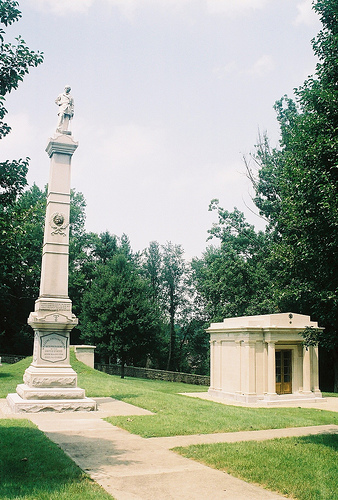
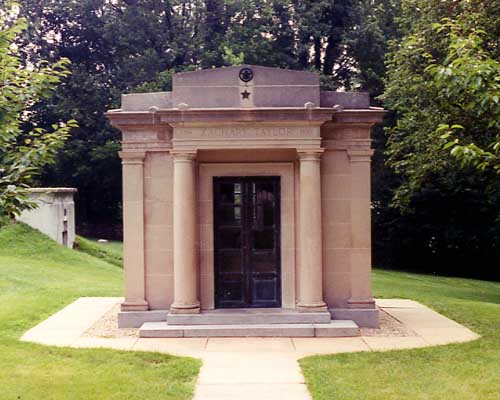
Interesting Fact:
Taylor's death came after only 16
months in office. During his 40 years as a soldier, he fought the
British, the Sauk, Fox, and Seminole Indian tribes, and the Mexicans.
His men called him "Old Rough and Ready" because he scorned fine, neat
military uniforms.
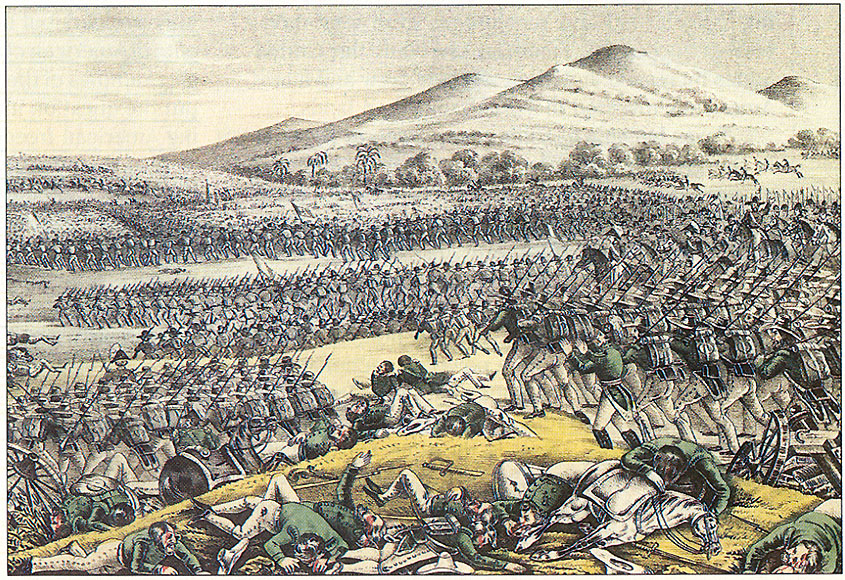
Copyright ©
1992-2022 by John T. Marck. All
Rights Reserved. This article and their accompanying pictures,
photographs, and line art, may not be resold, reprinted, or
redistributed for compensation of any kind without prior written
permission from the author. Information in part from The Presidents
of the United States, by John T. Marck.
A
Splendid Time Is Guaranteed For All
| | |
| |

